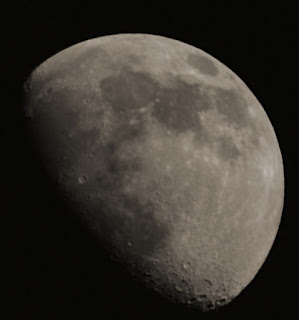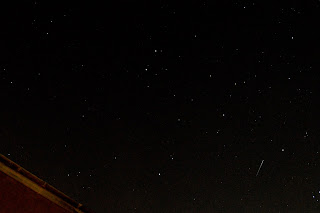March 30th 2150 GMT Moon
When we think of astronomy, we imagine crystal clear skies. Reality is often different. A sunny day gave way to a cloudy evening. The Moon was low down and in haze, so I needed to use 1/100 second exposure, instead of the 1/500 second exposure I would have used in better conditions. I was very pleased with the final result, though.
March 29th 2055 GMT Moon
The Moon was low but bright and only just past full. There were many sharp images and it was quite difficult to select the best.shot, a nice problem to have. When I processed the photo in GIMP, I was very pleased with the result.
March 27th 0210 GMT Moon
I did another shoot a few hours later but it was less sharp than the one the evening before.
March 26th 2050 GMT Moon
It was partially cloudy for most of the day. I was hoping to do a telescope shoot but it was not going to happen. I snapped the Moon at 300mm focal length, ISO 100 and 1/640 second exposure.
March 25th 2050 GMT Moon
An attempted lunar shot failed completely.
March 24th 1555 GMT Sun
I tried a solar hydrogen alpha shoot but all photos were ruined by cloud.
March 24th 1550 GMT Moon
With the weather in the evening being uncertain, I shot the Moon with my DSLR at 300mm focal length, ISO 100 and 1/320 second exposure.
March 23rd 2250 GMT Moon
I was overdue for a really good lunar imaging session. I had been pleased with my efforts with my DSLR but had hardly used my telescope all year. The Moon was high in the south west and well-placed from our conservatory to take some images without straining my hips, shoulders or back.
It was a shame that my Bresser Electronic Eyepiece was functionally challenged, so I decided to do one set of shots with my Mak and DSLR. I took 20 frames at 1.54m focal length, ISO 100 and 1/100 second exposure and stacked the best 18.
I inserted a 3x Barlow lens into the imaging train to boost the focal length to 4.62 metres. I increased the exposure time to 1/10 second. An alternative was to boost the ISO setting. I stacked 19 images taken around Mare Crisium to get this close-up.
I stacked four photos to get this image of some of the southern craters.
Clavius was in this stack of 12 images.
The next stack of 12 images showed Clavius and Tycho.

The next batch of 17 frames revealed Plato.
11 frames showed both Copernicus and Sinus Iridium.
The next 15 frames showed Copernicus in a central position.
The next 23 frames showed another group of southern craters.
Another 23 frames revealed some more craters.
10 more frames showed Copernicus.
The next 15 frames showed another view of Plato.
The final shot with 25 frames shows Plato and Sinus Iridium.
It was not a 100% successful shoot. Some shots worked quite well, others worked but showed little more detail than in the full disc shots. On reflection, I should have used a shorter exposure and higher ISO. We learn to experiment!
March 23rd 1825 GMT Moon
It was early dusk and the Moon was high in the sky.. I snapped it with my DSLR at 300mm focal length, ISO 100 and 1/320 second exposure.
March 22nd 1845 GMT Moon
I tried another set of shots during dusk. I kept the same focal length and exposure settings but reduced the ISO to 100.
March 22nd 1730 GMT Moon
The afternoon before, it was clear, so I thought it would still be clear after sunset. It wasn't and the opportunity was missed. I took no chances and did a shoot before sunset. The moon was just past first quarter but libration made Clavius stand out clearly. It was also nice to see Tycho without its rays.I used my DSLR at 300mm focal length, ISO 400 and 1/320 second exposure.
March 20th 2215 GMT Moon
Most of the sky was covered by various thicknesses of cloud. The Moon appeared to be in a clear patch of sky, so I had another go with the same settings.
March 20th 1955 GMT Moon
It was clearer a bit later but there was some thin cloud around. I tried the same settings as before and got a reasonable result.
March 20th 1845 GMT Moon
Conditions were poor but I had a go at the Moon with my DSLR at 300mm focal length, ISO 100 and 1/250 second exposure. No shots worked.
March 17th 2145 GMT Moon
I snapped the Moon with my DSLR at 300mm focal length, ISO 100 and 1/250 second exposure.
I switched lenses and settings to 18mm focal length, ISO6400 and 6 seconds exposure, or I thought I did. The first test shot showed that I had forgotten to set the ISO correctly. The second was more successful, showing Orion, Taurus and Canis Minor.
I stacked 15 of 18 images to get this snap of Gemini.
At 2012 GMT, I caught a meteor near Gemini that appeared to come from the direction of Canis Minor.
March 16th 2230 GMT Binocular Tour
I could not remember the last time I was able to do this.
Conditions were not perfect, especially near the horizon but I saw some nice
sights. This session overlapped with the previous one, as my camera was happily gathering photons. Firstly, I estimated Betelguese to be about magnitude 0.7, a small fade
and closer to Aldebaran in brightness.
My 15x70 binoculars showed the Orion Great Nebula (M42). The
Pleaides (M45) showed about 30 stars, a bit less than the 40 to 70 I usually
see. The best sight was the Beehive (M44) riding high in the south. I was also
able to capture the star cluster M35 in Gemini. The Leo galaxies M65 and M66
did not show and I could just make out a fuzzy path where the galaxy M81 in
Ursa Major should be. The Andromeda Galaxy (M31) was above the horizon but it
was low down in the murk.
March 16th 2130 GMT Meteor Scan
I set my camera up to catch meteors using my DSLR and intervalometer to take 6 second exposures at 18mm focal length, ISO 6400, as usual.
I started off doing a test shot of Gemini.
Unfortunately, I did not catch any meteors and the sky background overhead was not interesting.
March 16th 2100 GMT Deep Sky
Unlike the night before, it stayed clear after it became dark and the Moon was setting, as I performed a deep sky shoot. I started with my DSLR at 300mm focal length, ISO 6400 and 2 seconds exposure. It did not go to plan! On my first set of frames on the Pleaides (M45), I had problems with camera shake, despite using shutter remote control. I reduced the exposure to 1 second then tried to stack multiple images but Deep Sky Stacker wasn't co-operating. Despite my difficulties, I ended up with a passable result from a single frame.
Early in the session (2107 GMT), I saw a bright meteor that easily outshone Sirius but, at about magnitude -2, it was not bright enough to call a fireball. Still, it bright, red trail was a fine sight. Ironically, had I not been deep sky shooting, there was a more than even chance, I could have caught it in a meteor search.
I managed 3 reasonable frames of the Orion Great Nebula (M42) and they stacked well.
I changed to 70mm focal length, ISO 6400 and 6 seconds exposure. My first set of shots were of Orion's Belt and M42. It worked but I had taken better, similar shots in the past.
I stacked 10 frames of the Hyades with Mars.
The Mars with the Pleaides (M45) used the same method but produced a better result.
I tried to catch M35 but missed it.
March 16th 1855 GMT Moon
I repeated the lunar shot from the day before, with the same settings.
March 15th 1855 GMT Moon
I had another go with similar settings as it became darker.
I'm not sure which I prefer. I was hoping for some action in full darkness but it clouded over.
March 15th 1830 GMT Moon
It had been 8 days since my last successful day, with lots of frustration with the weather. I snapped the Moon about 30 hours since the new phase and caught some detail. I used my DSLR at 300mm focal length, ISO 400 and 1/200 second exposure.
March 11th 2040 GMT Meteor Hunt
It was partially clear but cold and windy, so I stayed
indoors and let my camera do the work at my usual meteor settings of 18mm focal
length, ISO 6400 and 6 seconds exposure. I aimed the camera overhead to avoid
clouds and extinction.
However, the photo shoot was a disaster. The shots were all out of focus and the battery ran out after 300 frames.
There was no particular reason why any part of the sky should
produce more meteors than others, apart from the zenith being better, because
there is less atmosphere for the light to pass through. I chose the north east
because it was a darker part of sky, with less light pollution. However, I
chose the Taurus area to make sure that the focus was not too far out.
I caught a short meteor trail at 2053 GMT.
I never caught any more but I stacked 7 of 25 images to get this shot of the Plough and Ursa Minor.



































































